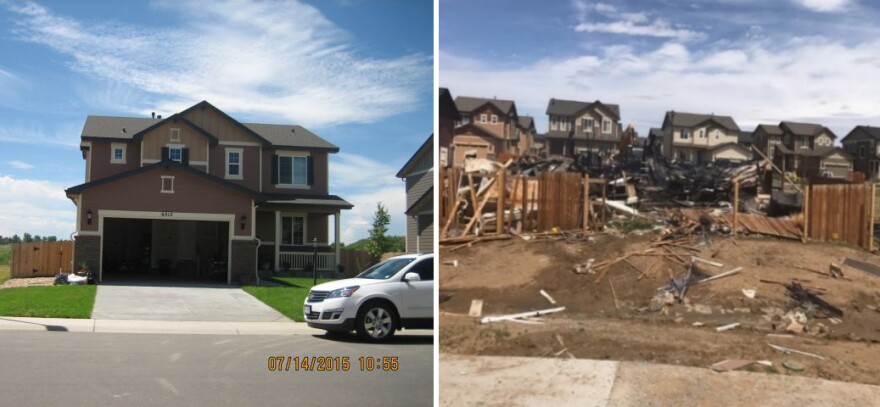Federal investigators released a highly-anticipated summary of the 2017 explosion in Firestone on Tuesday, prompting statements of frustration from the family at the center of the accident and renewed calls for government action to prevent similar tragedies.
In April 2017, a home in Firestone, a town north of Denver, exploded, killing Mark Martinez and his brother-in-law Joey Irwin. Another resident, Erin Martinez, was also severely burned.
The cause of the explosion was a leaky pipeline buried near the home. It was owned by a large oil and gas company, Anadarko Petroleum. The company has since been acquired by Occidental Petroleum.
In a report released Tuesday, the National Transportation Safety Board concluded the following:
“The National Transportation Safety Board determines that the probable cause of the explosion and fire at the Firestone, Colorado, residence was the ignition of fugitive natural gas that had migrated from the Coors V6-14Ji well through a pipeline that was not abandoned by Patina Oil and Gas Corporation and that was most likely severed in 2015 during the construction of the house.”
It goes on:
"Contributing to the accident was the approval by local authorities to allow occupied structures to be built on land adjacent to or previously part of oil and gas production fields without structures to be built on land adjacent to or previously part of oil and gas production fields without complete documentation from the operator, Anadarko Petroleum Corporation, on the location and status of its gathering system pipelines."
Many of the details outlined in the seven-page document are hardly revelatory to those familiar with the incident. In a statement, Erin Martinez called the report deeply disappointing in its brevity.
“Whoever authored this document could have released it a short time after my home exploded,” Martinez said. “It’s difficult to understand why it took two and a half years to write seven pages that provide no concrete recommendations to prevent another tragedy.”
The NTSB report provides no explanation for the time frame of its release. The board’s investigations are essentially fact-finding proceedings.
The report’s publication does mean the Colorado Oil and Gas Conservation Commission can proceed with plans to take punitive action against Anadarko (now Occidental). That could mean prosecution and/or a fine against the company from the agency’s enforcement division.
In a statement, Jennifer Brice, director of communications for Occidental in Colorado, said the company is taking the NTSB report’s findings seriously.
“As a part of our commitment to safety, we continually review our processes and procedures,” Brice said. “We are mindful of the events of April 17, 2017, every day, and our thoughts continue to be with the families, friends and communities affected by this tragedy.”

Key findings
The seven page report lays out the details of what happened in Firestone around 4:45 p.m. on April 17, 2017.
Mark Martinez, the home’s owner, and Joey Irwin, his brother-in-law, were replacing a water heater in the home’s basement. A nearby pipeline had been leaking fugitive natural gas for months, which then ignited.
The home instantly exploded, killing both Martinez and Irwin.

In the aftermath, NTSB investigators located a severed plastic pipeline beneath a concrete pad about 6 feet from the home’s foundation.
The pipe was connected to a nearby well, which was incorrectly abandoned, according to the report.
Investigators were unable to find any records showing when the pipeline, or flowline, was cut. Local building permits showed the only activity at the site that could have caused the cut was in 2015, when the new home was being built.
Over time, natural gas leaking from severed pipeline likely traveled through the soil into the home’s basement, where it caused the explosion.
Here's a copy of the report:
Focus on flowlines
The report comes as state regulators are trying to make underground pipeline locations more available to the public. The location of thousands of underground lines in Colorado remain largely unknown, and state efforts to map them have been sluggish.
In a series of rulemaking hearings expected to wrap up in late November, the COGCC is focusing on three new changes to its flowline rules:
Requiring location data for all “off-location” flowlines and crude oil transfer lines to be made public via the COGCC’s online map of the state’s oil and gas operations.
Enabling COGCC staff to conduct inspections when an operator takes action to reactivate an inactive flowline or temporarily abandoned oil and gas well.
Changes the presumption that is in place when a flowline is abandoned. Currently abandoned flowlines are allowed to remain in place. The draft rules change that. So, when a flowline is abandoned it needs to be removed.
Jeff Robbins, director of the COGCC, told KUNC in an interview on Tuesday he felt confident the changes would help prevent another incident like Firestone from happening.
“(They) do a good job at addressing the legislative mandate of relooking at flowlines in a manner that’s protective of health, safety, welfare, the environment and people,” Robbins said.
The COGCC, prompted by the passage of Senate Bill 181 , is in the midst of a major overhaul in several departments. The agency is updating its entire mission statement, upping scrutiny of new well applications and addressing air quality impacts of oil and gas operations.
Oil and gas industry groups have, in turn, sounded the alarm.
Dan Haley, president of the Colorado Oil and Gas Association, said in a statement that making flowline information more available to the public would put public safety at risk.
“That could encourage an expansion of the illegal trespassing and vandalism we’ve seen along major pipelines,” Haley said. “But as importantly, broad access to inaccurate maps could encourage people to skip the ‘Call Before You Dig’ 811 system, and put themselves at serious risk.”
The industry is still implementing a round of flowline rule changes state lawmakers passed last year, Haley added.
Despite progress that’s been made, many still say it isn’t enough. In her statement Tuesday, Erin Martinez said the NTSB report and the state’s existing flowline rules do not rise to a “level of great change.”
“I will turn my focus to the work of the Colorado Oil and Gas Conservation Commission and continue to serve the memory of both Mark and Joey in creating a safer Colorado and ensure that no other family will have to live through what my family experienced,” Martinez said.







